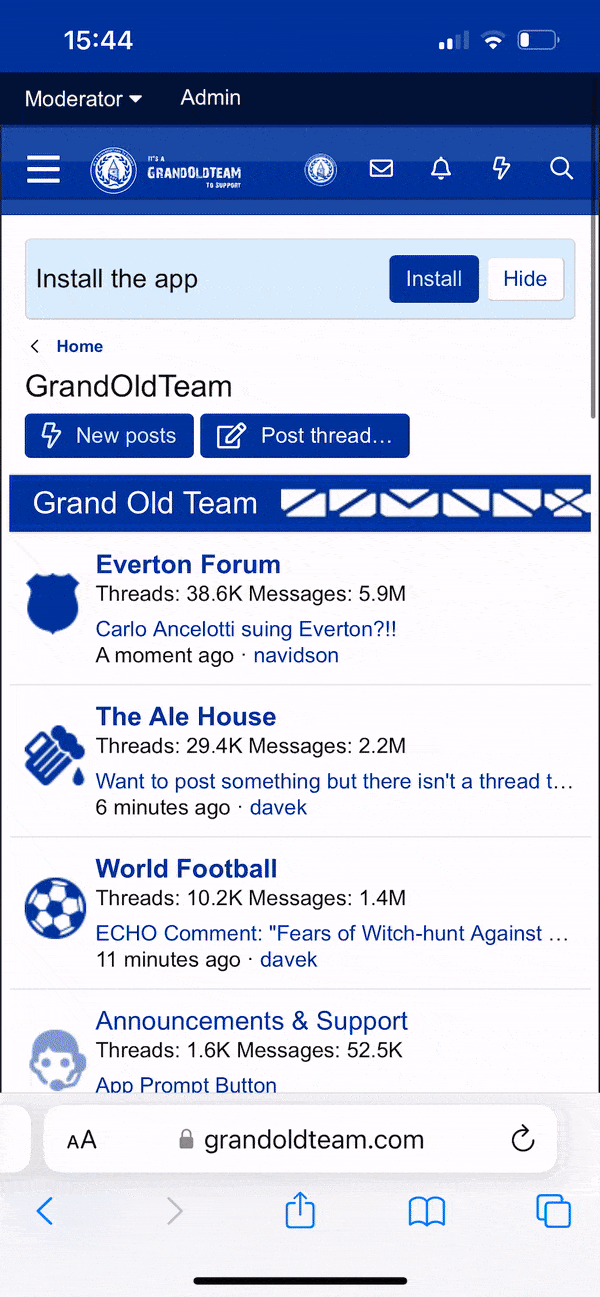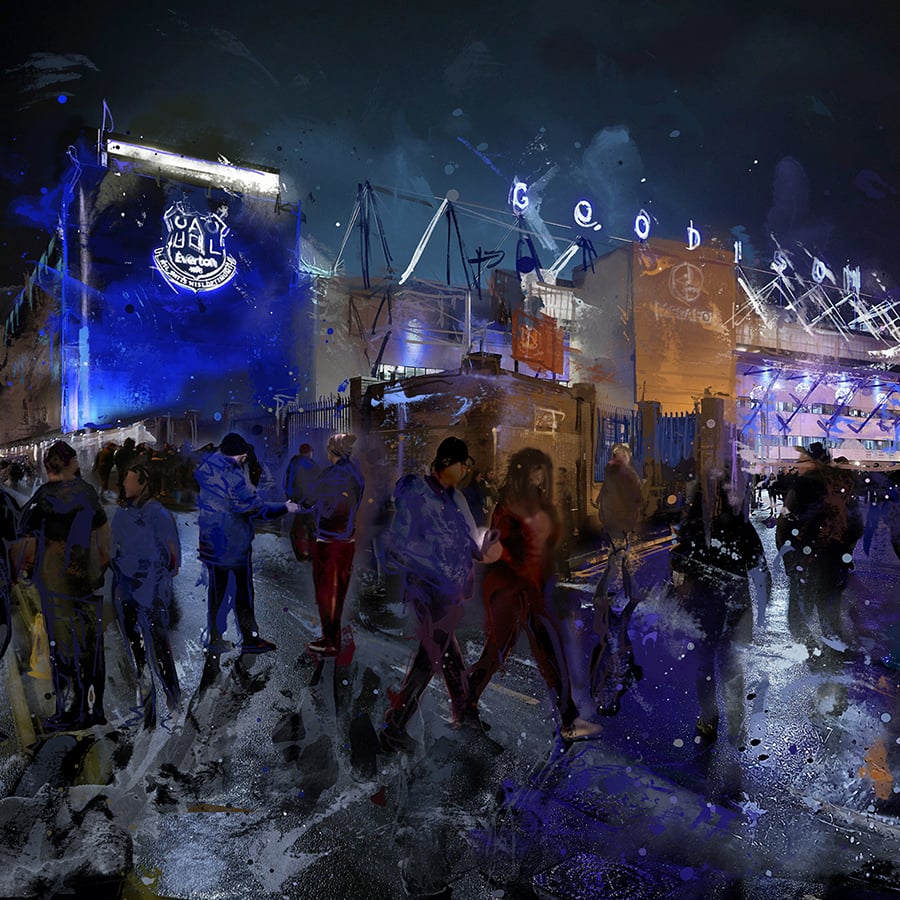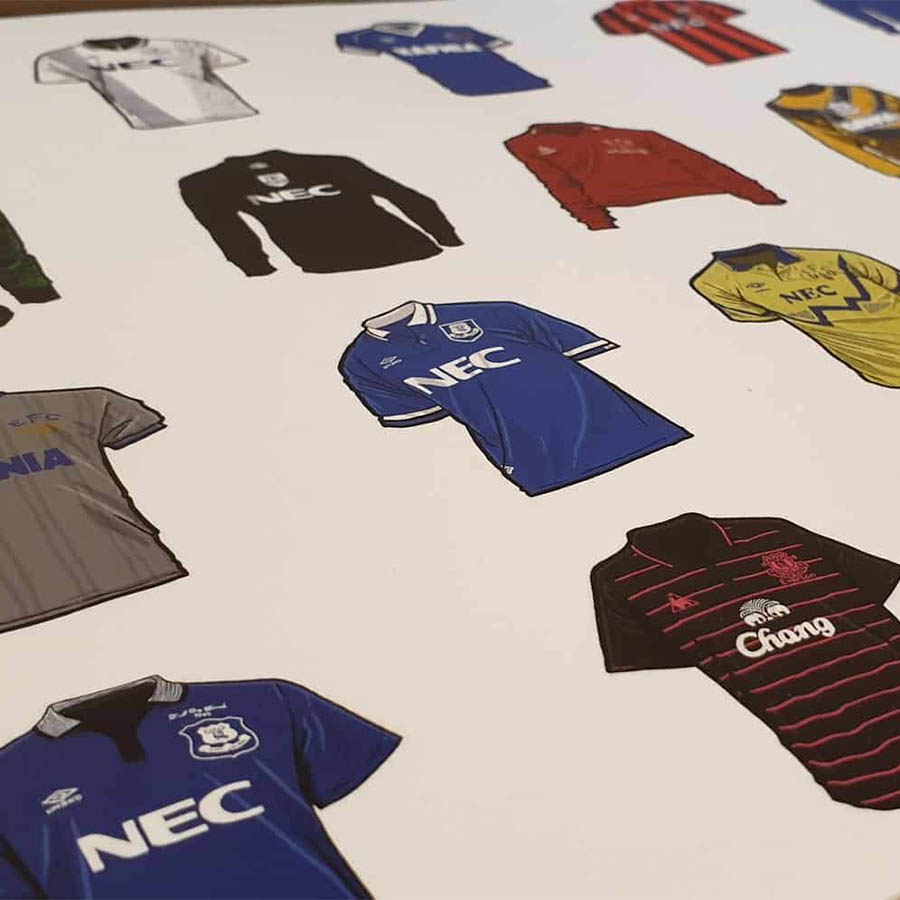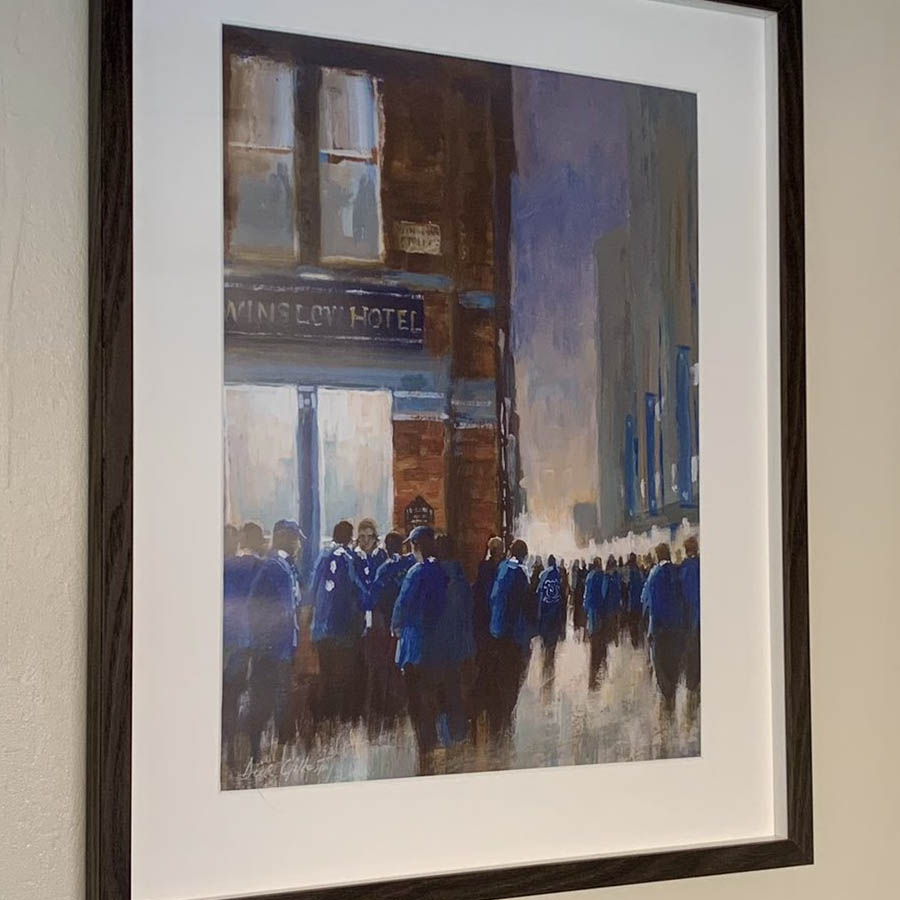catcherintherye
Player Valuation: £80m
catcherintherye submitted an update to GrandOldTeam's homepage
A Progressive Pricing Strategy
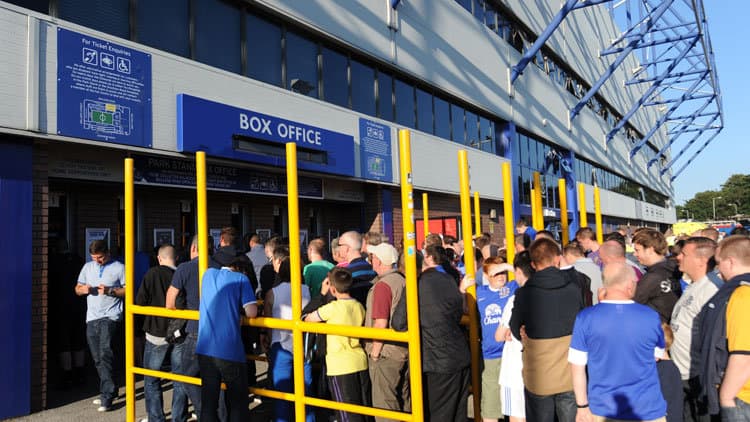
As a general rule I try to avoid speaking about Liverpool Football Club as much as possible. I am not sure it is massively productive for any business, fan, football team to become too concerned with what other, rival teams do. I meet a lot of Liverpool supporters who are part of the “scouse diaspora” who I greatly enjoy discussing football with, only the other day at the gym one stopped me and said he liked my shirt (it was the 1985 Cup Winners Cup shirt) and enthused about what a wonderful team it was and what a terrible shame it was that they didn’t get the chance to compete for the European Cup. He said he fancied them to win it. I reciprocated that the 88 Liverpool team was also a fantastic side and as a city neither of the two football clubs came out of the post Heysel landscape as profitably as they ought. Most people you meet who are from Liverpool to be grounded in a clear and insightful understanding of the game and I think for many Reds who move away they secretly appreciate Evertonians representation of the city more than they let on. Within the pressure cooker of the city itself I sense much of this is lost, as it is upon Liverpool fans who have little connection to the city and therein a limited understanding of the role Everton has within it. However for the most part my interactions with Liverpool fans is mainly cordial. As a result, as indicated above, I let them do their thing and try to focus on our own club.
However the latest round of what seems as increasingly bitter divide between aspects of the fanbase and the ownership over a pricing strategy to me throws up a number of interesting dilemma’s and comparisons to our club as we look to grow our brand. We also have to bare in mind (whether we like it or not) their approach will have both an indirect and direct affect on ourselves as a club. Sharing a city with a competitor means this is an unfortunate reality, not a representation of some mythical bitterness that some of the more backward and reactionary elements of Liverpool’s fanbase claim.
The origins of Liverpool’s current debate cane be traced back 18 months or so to the original pricing plan outlined by FSG upon the completion of the new Main Stand. There was some suggestion most prices would be increased, while tickets could be as high as £77.00 per match. This led to a protest from Liverpool fans, thousands of fans leaving on the 77th minute and FSG almost immediately reversing the decision almost immediately. I always felt this was a sensible move and had obviously feared as a rival they would put it behind them and move forward in the spirit of fairness and decency around pricing on the back of the u-turn. However what became apparent as time went by was that FSG hadn’t so much as learned from a mistake, but seen the problems as an issue that may have around timing as opposed to substance.
The crux of the problem for LFC appears to be the contradictory nature of their club. On the one hand, it is located in a working class city, which is very proud of it’s roots and traditions and keen to maintain it’s connection to the local community. Yet on the other it is a global business and a European super club, with an international fanbase built up in part during an almost unrivalled level of success between 1971-1990. These tensions seem further heightened by the fact they have international owners who see it very much as a business, but who came to own the club in no small part off the back of a campaign driven and rooted in the local fan base. When you read comments and accounts of what people want there are numerous differing and often contradictory perspectives, yet many can be broadly grouped into the above two camps.
Shortly after the U-turn from FSG comments where made that it was a temporary reprieve. CEO Ian Eyre had also tried to sell the benefits of the deal on the basis of a (relatively) small number of cheap tickets available for those with a L postcode. FSG then seemed to up the ante further by calling into question the viability of the redevelopment of the Anfield Road End without the ability to hike up ticket prices. There are some rumours that planning permission may have expired on this development and even if these are untrue you can only imagine that the point at which it expires will be approaching. The latest siren in the war of words appeared to be yesterday, where the club detailed a consultation and when asked on lower ticket prices included the statement that “at some point the revenue generated from ticket sales will have to go up”.
What underpins FSG’s approach is a logical desire to monetize an asset. While almost every Premier League club now sell out almost every game, it is easy to see where a ticket shortage, particularly for big games would be more acute for Liverpool. With demand outstripping supply the logical answer is to drive up revenue by raising costs. The reality is also that the cost involved in adding 5/6k extra seats in the Anfield Road End will unlikely be met in an agreeable time frame unless costs are increased. Likewise, the desire to get a commercial naming partner for the new stand has proven difficult, as understandably the best opportunities for this lie in new stadiums who as yet have no name attached to them, not for stands in grounds that have a well established brand. I suspect FSG want to drive costs up across the board, with a handful of premium seats, a larger collection at semi-premium and try to sugar coat the message with a handful of cheaper tickets for local fans. Rightly many Liverpool fans have seen through this as tokenistic and is indicative of a wider attitude towards the local fan base.
While in many ways it makes financial sense to drive the costs up, what cannot be understated is the longer term damage this does. With the multitude of revenue streams that have opened up for football clubs, particularly those at the top end of the league has meant the revenue generated on match days takes a more peripheral role than even 20 years ago. An increase of say £20 per fan per game would be well below 10% of Liverpool turnover, yet the negative impact of pricing supporters our of being able to afford to go and watch the team could be seen as a far greater risk. Such an increase will impact upon a supporters in a more traditional working class city like Liverpool than from those outside of the area and in many ways further compound the difficulties faced.
This is very much the context with which Everton now operate in. While it is fair to say if you remove a 20 year period between 1970-1990 the two clubs achievements are broadly comparable, the fact those decades still remain in many people’s lifetimes means Everton are very much the underdog in terms of attracting new supporters. This is in part compounded by a trophyless run since 1995, allied to Liverpools achievements in the early part of this century and the more competent approach to growing the business they have had in the lean years. What remains impressive with Everton through that period though, is even in the face of stiff competition the ability to maintain a fanbase in the mid to late 30 thousands. Over the last few years, where most (if not all) games are sold out it is clear our fanbase is not bigger than 40,000 and while it is very difficult to predict I suspect our average attendance would be near to 50,000 if size was no issue.
The story that gets told around this, is that it is down centrally to a super loyalty of Evertonians. While there is little doubt that there is a loyalty, attachment and resilience to the club that Evertonians have that few can match, much of can also be put down to some (rare) sensible strategic planning at board level. The commitment to affordable ticketing, particularly for young supporters (with the 100 pound season tickets) has been an enormous success in continually capturing a new generation of supporters. The fact the benefits are now rolled out to those under 21 and students is another sensible strategy as it eases supporters from being children into full paying adults in a tiered way rather than one big jump and will likely lead to less fans dropping off. Whereas FSG see affordable ticketing as a tokenistic gesture few can doubt the continued commitment to getting local supporters into the ground and how that is embedded across our club, and can be seen by the pride with which Elstone speaks of the number of young fans who are season ticket holders. In no small part has this underpinned our ability not just to maintain but grow our fanbase in the face of stiff competition.
As our new stadium progresses forward it is important that we learn not just on our successes, some of Liverpool’s mistakes but also see the opportunities that arise from this. I firmly believe, with the new ground bounce we would fill a 60k seater most weeks, but I also think it provides a unique opportunity to build the profile and presence of the club in the city and the surrounding areas as well attract commercial partners. As I have suggested above, I don’t believe it’s easy to put a price on having a fanbase particularly in the area you are based. The supporters are your best ambassadors, sales people and business assets. Liverpool remind me of a club who have taken for granted the local population at board level and if they push ahead with the higher ticketing costs will drive even more young supporters towards the football club in the city they can afford to support, which should be Everton.
Football remains a unique industry in just how few supporters (customers as it were) change brand. In a globalized world, underpinned by the neo-liberal illusion of choice there has been an erosion of brand loyalty in most areas, yet this has not really filtered through to football supporters. Children around the age of 6/7 make a choice of football team that will likely remain with them for the rest of their lives. When I was supporter, most chose teams around 1994/5 and I would say as many as 30-35% of my friends changed teams to support the 1993/4 champions Manchester United. Even after 2 league titles the volatile nature of children had seen them dominate as the most popular team. It is an anathema to me that Manchester City for example could dominate Manchester for supporters of young fans as they now do, yet the 5 years in the relative wilderness Manchester United have hit them hard. As a teacher you would see first hand how quickly trends would change, but also know once someone committed to a team it was a match made forever. In such a unique and challenging marketplace, complacency is a major weakness and if it’s shown in one of your nearest rivals it presents a fantastic opportunity.
The approach that The Esk (amongst others) has put forward and one that seems to chime easily for Moshiri appears to be that we look to hold costs down for the majority of supporters while having a minority of seats sold at a premium price. While my preference would be that we have no luxury or semi-luxury seats, given the way football has gone it may be a small price to pay to allow for us to further expand the numbers of local and young fans who can watch Everton play on a regular basis. It appears an approach that seems the opposite of what Liverpool are going for, where for them the majority pay more for a few local fans to have access, what we are looking to do is have a minority pay more so a majority of local fans can see the match. While this may lead to less value in crass monetary terms, the value of having significantly higher local and young season ticket holders cannot be understated.
This approach ought to be allied to a far broader and likely more aggressive approach to how we use the stadium. While it is probably a debate for another platform I think we need to view the stadium as a space that can come to signify Everton Football Club in what it does not just on the pitch but also off the pitch. For me there ought to be a lounge for former players, managers, the academy and also EITC. Given the increasing pressures around Brexit, but also tightening of tax loopholes it may prove more challenging to attract corporate clients for boxes (even in a groundbreaking stadium situated in arguably the most beatific waterway in the UK) and therefore using some boxes not just for corporate hospitality but as a hub space that can be used the whole year around would seem a forward thinking measure. Likewise there needs to a Museum, partly dedicated to Everton, partly to football and how the two intertwine that can be educational in focus with the aim of looking to have it filled every none match day with local schools in the area. This can not just match up easily with the progressive pricing structure, but may also be able to be linked in with former players/managers having a role in making the displays interactive. We should aim not just to have a world class stadium for Match days, but a unique and warm space that can be utilised by the local community all year around.
Undoubtedly Everton FC are coming from well behind their neighbours when it comes to building a brand. Yet clubs grow and decline at differing speeds, and when your rival can be seen to be making a mistake it presents an opportunity. For Everton the time is now to begin to seize that opportunity and once again overtake LFC to restore the balance of power that exists before the 1970’s. The opposite approach doesn’t just exist in terms of pricing structure but also approach. LFC have endless consultations and essentially present bad news in a transparent and open way. Evertons board currently seem to want to hide communicating good news. If there is one thing I would borrow from LFC’s board it is the openness they are conducting these meetings and the willingness to put their viewpoint out there. That will be increasingly important as the stadium move progresses forward.
A Progressive Pricing Strategy

As a general rule I try to avoid speaking about Liverpool Football Club as much as possible. I am not sure it is massively productive for any business, fan, football team to become too concerned with what other, rival teams do. I meet a lot of Liverpool supporters who are part of the “scouse diaspora” who I greatly enjoy discussing football with, only the other day at the gym one stopped me and said he liked my shirt (it was the 1985 Cup Winners Cup shirt) and enthused about what a wonderful team it was and what a terrible shame it was that they didn’t get the chance to compete for the European Cup. He said he fancied them to win it. I reciprocated that the 88 Liverpool team was also a fantastic side and as a city neither of the two football clubs came out of the post Heysel landscape as profitably as they ought. Most people you meet who are from Liverpool to be grounded in a clear and insightful understanding of the game and I think for many Reds who move away they secretly appreciate Evertonians representation of the city more than they let on. Within the pressure cooker of the city itself I sense much of this is lost, as it is upon Liverpool fans who have little connection to the city and therein a limited understanding of the role Everton has within it. However for the most part my interactions with Liverpool fans is mainly cordial. As a result, as indicated above, I let them do their thing and try to focus on our own club.
However the latest round of what seems as increasingly bitter divide between aspects of the fanbase and the ownership over a pricing strategy to me throws up a number of interesting dilemma’s and comparisons to our club as we look to grow our brand. We also have to bare in mind (whether we like it or not) their approach will have both an indirect and direct affect on ourselves as a club. Sharing a city with a competitor means this is an unfortunate reality, not a representation of some mythical bitterness that some of the more backward and reactionary elements of Liverpool’s fanbase claim.
The origins of Liverpool’s current debate cane be traced back 18 months or so to the original pricing plan outlined by FSG upon the completion of the new Main Stand. There was some suggestion most prices would be increased, while tickets could be as high as £77.00 per match. This led to a protest from Liverpool fans, thousands of fans leaving on the 77th minute and FSG almost immediately reversing the decision almost immediately. I always felt this was a sensible move and had obviously feared as a rival they would put it behind them and move forward in the spirit of fairness and decency around pricing on the back of the u-turn. However what became apparent as time went by was that FSG hadn’t so much as learned from a mistake, but seen the problems as an issue that may have around timing as opposed to substance.
The crux of the problem for LFC appears to be the contradictory nature of their club. On the one hand, it is located in a working class city, which is very proud of it’s roots and traditions and keen to maintain it’s connection to the local community. Yet on the other it is a global business and a European super club, with an international fanbase built up in part during an almost unrivalled level of success between 1971-1990. These tensions seem further heightened by the fact they have international owners who see it very much as a business, but who came to own the club in no small part off the back of a campaign driven and rooted in the local fan base. When you read comments and accounts of what people want there are numerous differing and often contradictory perspectives, yet many can be broadly grouped into the above two camps.
Shortly after the U-turn from FSG comments where made that it was a temporary reprieve. CEO Ian Eyre had also tried to sell the benefits of the deal on the basis of a (relatively) small number of cheap tickets available for those with a L postcode. FSG then seemed to up the ante further by calling into question the viability of the redevelopment of the Anfield Road End without the ability to hike up ticket prices. There are some rumours that planning permission may have expired on this development and even if these are untrue you can only imagine that the point at which it expires will be approaching. The latest siren in the war of words appeared to be yesterday, where the club detailed a consultation and when asked on lower ticket prices included the statement that “at some point the revenue generated from ticket sales will have to go up”.
What underpins FSG’s approach is a logical desire to monetize an asset. While almost every Premier League club now sell out almost every game, it is easy to see where a ticket shortage, particularly for big games would be more acute for Liverpool. With demand outstripping supply the logical answer is to drive up revenue by raising costs. The reality is also that the cost involved in adding 5/6k extra seats in the Anfield Road End will unlikely be met in an agreeable time frame unless costs are increased. Likewise, the desire to get a commercial naming partner for the new stand has proven difficult, as understandably the best opportunities for this lie in new stadiums who as yet have no name attached to them, not for stands in grounds that have a well established brand. I suspect FSG want to drive costs up across the board, with a handful of premium seats, a larger collection at semi-premium and try to sugar coat the message with a handful of cheaper tickets for local fans. Rightly many Liverpool fans have seen through this as tokenistic and is indicative of a wider attitude towards the local fan base.
While in many ways it makes financial sense to drive the costs up, what cannot be understated is the longer term damage this does. With the multitude of revenue streams that have opened up for football clubs, particularly those at the top end of the league has meant the revenue generated on match days takes a more peripheral role than even 20 years ago. An increase of say £20 per fan per game would be well below 10% of Liverpool turnover, yet the negative impact of pricing supporters our of being able to afford to go and watch the team could be seen as a far greater risk. Such an increase will impact upon a supporters in a more traditional working class city like Liverpool than from those outside of the area and in many ways further compound the difficulties faced.
This is very much the context with which Everton now operate in. While it is fair to say if you remove a 20 year period between 1970-1990 the two clubs achievements are broadly comparable, the fact those decades still remain in many people’s lifetimes means Everton are very much the underdog in terms of attracting new supporters. This is in part compounded by a trophyless run since 1995, allied to Liverpools achievements in the early part of this century and the more competent approach to growing the business they have had in the lean years. What remains impressive with Everton through that period though, is even in the face of stiff competition the ability to maintain a fanbase in the mid to late 30 thousands. Over the last few years, where most (if not all) games are sold out it is clear our fanbase is not bigger than 40,000 and while it is very difficult to predict I suspect our average attendance would be near to 50,000 if size was no issue.
The story that gets told around this, is that it is down centrally to a super loyalty of Evertonians. While there is little doubt that there is a loyalty, attachment and resilience to the club that Evertonians have that few can match, much of can also be put down to some (rare) sensible strategic planning at board level. The commitment to affordable ticketing, particularly for young supporters (with the 100 pound season tickets) has been an enormous success in continually capturing a new generation of supporters. The fact the benefits are now rolled out to those under 21 and students is another sensible strategy as it eases supporters from being children into full paying adults in a tiered way rather than one big jump and will likely lead to less fans dropping off. Whereas FSG see affordable ticketing as a tokenistic gesture few can doubt the continued commitment to getting local supporters into the ground and how that is embedded across our club, and can be seen by the pride with which Elstone speaks of the number of young fans who are season ticket holders. In no small part has this underpinned our ability not just to maintain but grow our fanbase in the face of stiff competition.
As our new stadium progresses forward it is important that we learn not just on our successes, some of Liverpool’s mistakes but also see the opportunities that arise from this. I firmly believe, with the new ground bounce we would fill a 60k seater most weeks, but I also think it provides a unique opportunity to build the profile and presence of the club in the city and the surrounding areas as well attract commercial partners. As I have suggested above, I don’t believe it’s easy to put a price on having a fanbase particularly in the area you are based. The supporters are your best ambassadors, sales people and business assets. Liverpool remind me of a club who have taken for granted the local population at board level and if they push ahead with the higher ticketing costs will drive even more young supporters towards the football club in the city they can afford to support, which should be Everton.
Football remains a unique industry in just how few supporters (customers as it were) change brand. In a globalized world, underpinned by the neo-liberal illusion of choice there has been an erosion of brand loyalty in most areas, yet this has not really filtered through to football supporters. Children around the age of 6/7 make a choice of football team that will likely remain with them for the rest of their lives. When I was supporter, most chose teams around 1994/5 and I would say as many as 30-35% of my friends changed teams to support the 1993/4 champions Manchester United. Even after 2 league titles the volatile nature of children had seen them dominate as the most popular team. It is an anathema to me that Manchester City for example could dominate Manchester for supporters of young fans as they now do, yet the 5 years in the relative wilderness Manchester United have hit them hard. As a teacher you would see first hand how quickly trends would change, but also know once someone committed to a team it was a match made forever. In such a unique and challenging marketplace, complacency is a major weakness and if it’s shown in one of your nearest rivals it presents a fantastic opportunity.
The approach that The Esk (amongst others) has put forward and one that seems to chime easily for Moshiri appears to be that we look to hold costs down for the majority of supporters while having a minority of seats sold at a premium price. While my preference would be that we have no luxury or semi-luxury seats, given the way football has gone it may be a small price to pay to allow for us to further expand the numbers of local and young fans who can watch Everton play on a regular basis. It appears an approach that seems the opposite of what Liverpool are going for, where for them the majority pay more for a few local fans to have access, what we are looking to do is have a minority pay more so a majority of local fans can see the match. While this may lead to less value in crass monetary terms, the value of having significantly higher local and young season ticket holders cannot be understated.
This approach ought to be allied to a far broader and likely more aggressive approach to how we use the stadium. While it is probably a debate for another platform I think we need to view the stadium as a space that can come to signify Everton Football Club in what it does not just on the pitch but also off the pitch. For me there ought to be a lounge for former players, managers, the academy and also EITC. Given the increasing pressures around Brexit, but also tightening of tax loopholes it may prove more challenging to attract corporate clients for boxes (even in a groundbreaking stadium situated in arguably the most beatific waterway in the UK) and therefore using some boxes not just for corporate hospitality but as a hub space that can be used the whole year around would seem a forward thinking measure. Likewise there needs to a Museum, partly dedicated to Everton, partly to football and how the two intertwine that can be educational in focus with the aim of looking to have it filled every none match day with local schools in the area. This can not just match up easily with the progressive pricing structure, but may also be able to be linked in with former players/managers having a role in making the displays interactive. We should aim not just to have a world class stadium for Match days, but a unique and warm space that can be utilised by the local community all year around.
Undoubtedly Everton FC are coming from well behind their neighbours when it comes to building a brand. Yet clubs grow and decline at differing speeds, and when your rival can be seen to be making a mistake it presents an opportunity. For Everton the time is now to begin to seize that opportunity and once again overtake LFC to restore the balance of power that exists before the 1970’s. The opposite approach doesn’t just exist in terms of pricing structure but also approach. LFC have endless consultations and essentially present bad news in a transparent and open way. Evertons board currently seem to want to hide communicating good news. If there is one thing I would borrow from LFC’s board it is the openness they are conducting these meetings and the willingness to put their viewpoint out there. That will be increasingly important as the stadium move progresses forward.

